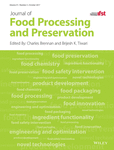Study on the Influence of Pressure-Assisted Thermal Processing on PET/PE via the Change of Melting Enthalpy
Abstract
The effect of Pressure-assisted thermal processing (PATP) on mechanical and barrier properties of polyethylene terephthalate (PET)/polyethylene (PE) for sausage packaging was studied. The samples were subjected to 150, 300 and 450 MPa for 10 minutes at temperatures of 25, 40 and 50C, separately. The delamination and bubbling occurred. The mechanical properties of PET/PE increased after the processing except that under 150 MPa, 50C and 450 MPa at 40C. Both tensile strength and barrier properties presented significant decrease and fluctuations under 450 MPa at 40 and 50C. The results indicated that high pressure and thermal processing might have opposite effects on PET/PE.
Practical Applications
Pressure-assisted thermal processing (PATP) is a combined process to inactive bacterial spores especially for low-acid foods. In 2009, the US FDA approved a petition for the commercial use of PATP for low-acid foods, which opened up opportunity for processing a variety of heat sensitive products. Study on the impact of PATP on packaging material, such as seal integrity, barrier properties to oxygen and water vapor, can ensure food quality during the shelf life.




